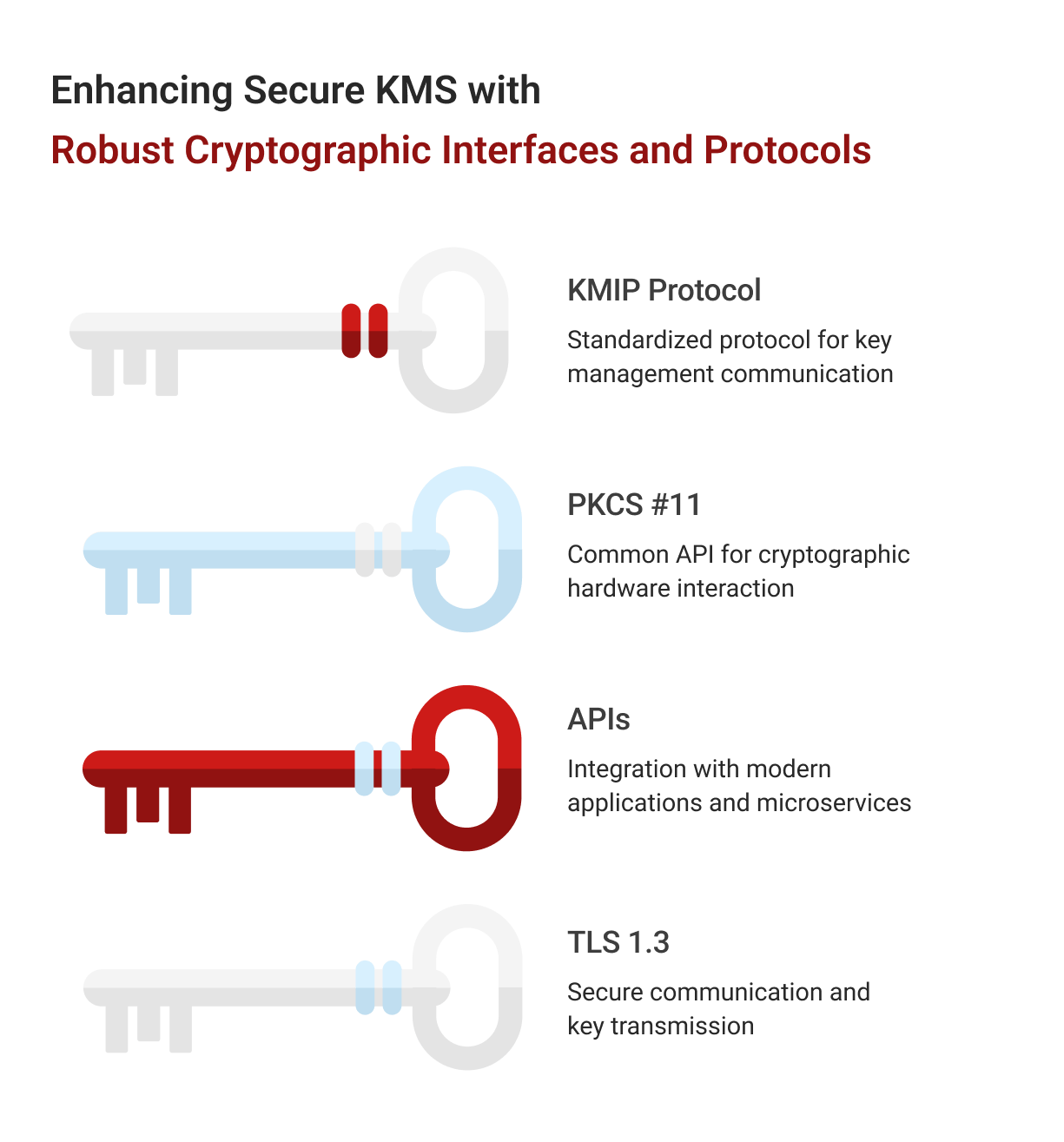How to Choose a Key Management Server
Table of Contents
Encryption is only as strong as your ability to manage the keys. In many breach investigations, the weak link isn't encryption but poor key management.
Choosing the right Key Management Server (KMS) is a strategic decision, not a technical one.
The right Key Management Server does more than satisfy compliance checklists. It safeguards your data at scale, adapts to complex cloud environments, and reduces operational friction.
Suppose you work in a highly regulated industry like finance, healthcare, or government, or rely on multi-cloud infrastructure. In that case, your Key Management Solutions (KMS) becomes a foundational pillar of data protection and business continuity.
Key Functions of a KMS: A Quick Overview
A key management server handles encryption keys efficiently, automating tasks to maintain security and compliance with minimal effort.
Its core functions include:
- Key generation: Creates strong encryption keys that are resistant to hacking attempts. It uses random number generators and relies on dedicated hardware for even greater security.
- Key storage: Protects keys in a secure vault like an HSM from unauthorized access.
- Key distribution: Securely sends keys to authorized users and systems, using strong encryption methods like TLS to prevent eavesdropping.
- Key rotation: Automatically replaces keys regularly to limit the damage if a key is compromised.
- Key revocation & expiry: Immediately cancel compromised keys and replace old keys on time to avoid security risks.
- Access control: Limits access to keys based on roles and attributes, ensuring only authorized personnel can use them.
- Audit logging: Keeps a detailed record of all key activities for compliance and security audits.
5 Tips for Choosing a Key Management Server
Selecting the correct key management server (KMS) ensures robust security, regulatory compliance, operational efficiency, and future scalability.
Organizations must carefully evaluate five key considerations before choosing a KMS solution.
1. Key Management Server
Compliance and security standards
A key management server (KMS) must comply with industry regulations and follow security best practices.
Encryption and key management must adhere to strict regulatory standards to protect sensitive information, reduce risks, and meet legal requirements. Key compliance frameworks to consider include:
Industry-specific compliance requirements:
- GDPR: Mandates strict encryption and key management practices to safeguard the personal data of EU citizens.
- HIPAA: Requires healthcare organizations to implement encryption and secure key management to protect patient data.
- PCI-DSS: Governs encryption practices to protect cardholder data from breaches and fraud.
- FIPS 140-2/140-3: Defines security requirements for cryptographic modules used within federal systems, financial institutions, healthcare, and cloud service providers.
- NIST SP 800-57: Establishes best practices for cryptographic key management, including key lifecycles, handling, and disposal.
- SOC 2 Type II: Ensures data security, availability, and confidentiality of cloud services.
Cryptographic security mechanisms:
To protect encryption keys and stop unauthorized access, a KMS needs to use strong encryption methods. Some of the most well-known encryption standards include:
- AES-256: Industry-standard encryption for securing data at rest and in transit.
- RSA-4096: Provides secure public-key encryption for key exchange and digital signatures.
- ECC: Offers a highly secure and efficient method for public-key encryption with smaller key sizes.
- SHA-256 and SHA-512: Ensures data integrity by generating cryptographic hash values.
A secure KMS should also protect against threats such as quantum computing by supporting post-quantum cryptography algorithms as they become standardized.
2. Key Management Server Deployment Flexibility
Organizations have diverse IT environments, ranging from on-premises data centers to multi-cloud architectures. A KMS must offer flexible deployment models to accommodate different security and operational requirements:
Deployment models:
On-premises KMS:
- Provides complete control over encryption keys and key management policies.
- Ideal for organizations with stringent security and compliance needs.
- Ensures data sovereignty by keeping encryption keys within local infrastructure.
- Offers scalability and automation for key lifecycle management.
- Seamless integration with cloud providers such as AWS Key Management Service (AWS KMS), Azure Key Vault, and Google Cloud KMS.
- Enables centralized management of cryptographic keys across cloud environments.
- Combining on-premises and cloud-based key management for maximum flexibility.
- Allows enterprises to maintain control over sensitive keys while leveraging cloud scalability.
- Prevents cloud vendor lock-in by enabling multi-cloud encryption consistency.
3. Key Management Server
Integration and Compatibility
A KMS must integrate with various enterprise applications, security tools, and cryptographic hardware effortlessly. Supporting multiple platforms ensures streamlined encryption and decryption processes across an organization's infrastructure.
Key integration requirements:
- Enterprise applications: ERP, CRM, and custom business applications should be able to access encrypted data without disruptions.
- Cloud providers: Compatibility with major cloud environments (AWS, Azure, Google Cloud) ensures a unified encryption strategy.
- HSMs: Integration with HSMs adds an extra layer of physical security for key storage.
- Identity and access management systems: Ensures robust authentication and role-based access to encryption keys.
- DevOps pipelines: Secure integration with CI/CD workflows prevents unauthorized key exposure during software deployment.
Cryptographic interfaces and APIs:
A secure KMS should support various cryptographic standards and communication protocols, including:

- KMIP: Standardized protocol for key management communication between KMS and clients.
- PKCS #11: Provides a standard API for interacting with cryptographic hardware.
- RESTful and gRPC APIs: Enables seamless integration with modern applications and microservices architectures.
- TLS 1.3: Ensures secure communication and encryption key transmission over networks.
4. Key Management Server
Usability and Management
A KMS should provide user-friendly management capabilities while maintaining strict security policies. Essential usability features include:
Centralized management console:
- Provides a unified dashboard for key lifecycle monitoring.
- Displays real-time key usage and encryption activity.
Automated key rotation and expiry:
- Reduces human error and strengthens security.
- Ensures compliance with industry best practices.
Role-based access control (RBAC):
- Enforces the principle of least privilege (PoLP) by restricting key access based on roles.
- Prevents unauthorized users from handling encryption keys.
Real-time alerts and logging:
- Notifies administrators of anomalies, unauthorized access attempts, and key expirations.
- Integrates with Security Information and Event Management (SIEM) tools for threat analysis.
Backup and recovery mechanisms:
- Ensures redundancy and availability of encryption keys.
- Protects against data loss due to system failures.
5. Key Management Server
Vendor support and long-term reliability
Not all KMS vendors offer the same security, support, or scalability level. Organizations must assess vendor capabilities to ensure long-term reliability and business continuity. Vendor Capabilities to Evaluate:
- Security expertise and reputation:
- Verify the vendor's track record in encryption technology and key management solutions.
- Assess independent security audits and third-party certifications.
- 24/7 technical support:
- Availability of global support teams for critical incident response.
- Access to security experts for troubleshooting and guidance.
- Regular security updates:
- Frequent software patches to mitigate vulnerabilities and strengthen defenses.
- Transparent security advisories and product roadmap updates.
- High availability and redundancy:
- Supports failover mechanisms to prevent single points of failure.
- Provides disaster recovery options to maintain business continuity.
- Future-proof scalability:
- Ability to handle increasing encryption key demands as an organization grows.
- Supports evolving cryptographic advancements, including quantum-resistant encryption.
Next Steps
A well-chosen Key Management Server strengthens your entire security framework. It protects what matters most, your encryption keys, while supporting compliance, scalability, and resilience.
But it's not just about technical features.
The real value comes from aligning your KMS choice with how your organization operates and grows.
When selected intentionally, a KMS becomes more than a backend utility.
It becomes a quiet but critical enabler of trust, control, and future-proof data protection.
FAQ
1. What is a Key Management Server (KMS)?
A Key Management Server (KMS) is a system that creates, stores, distributes, and manages cryptographic keys to protect sensitive data. It ensures secure lifecycle management for encryption keys across an organization.
In enterprise environments, a Key Management Server is critical for maintaining data confidentiality, enforcing policy controls, and enabling secure communication between systems. You can learn more about how KMS fits into modern encryption strategies in our page on Enterprise Key Management Systems: A Practical Overview.
2. How does a KMS support compliance with regulations like HIPAA or GDPR?
A Key Management Solution (KMS) supports compliance by enforcing strong encryption policies, controlling key access, and maintaining audit trails - requirements outlined in data protection regulations such as HIPAA, GDPR, and PCI DSS.
Regulators expect organizations to prove how data is encrypted and who controls access. Centralized Key Management Systems ensure consistent key rotation, role-based access, and detailed logging. For a deeper dive, please take a look at our article on Meeting Compliance Requirements with Centralized Key Management.
3. What’s the difference between cloud-based and on-premises KMS solutions?
Cloud-based Key Management Systems are hosted by a third-party provider, offering flexibility, scalability, and faster deployment. On-premises Key Management Systems give organizations complete control over their infrastructure and cryptographic operations.
Each option comes with trade-offs in latency, control, and regulatory scope. Hybrid models often blend both to meet enterprise demands. Please review our breakdown on choosing the right Key Management Solution (KMS): Cloud, On-Premises, or Hybrid.
4. How can I integrate a KMS with AWS, Azure, or Google Cloud?
Futurex Key Management Solutions supports directly integrating major cloud platforms like AWS, Azure, and Google Cloud through industry-standard APIs and native connectors.
This allows organizations to centralize key control while encrypting workloads across cloud environments. Review our Cloud Integration with Futurex Key Management for a step-by-step integration guide.


